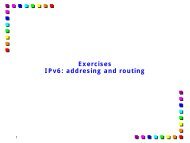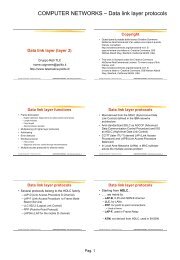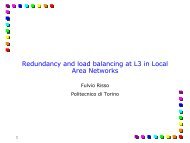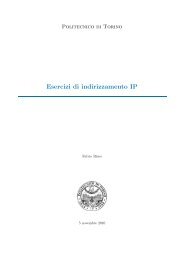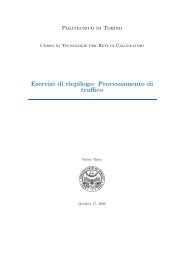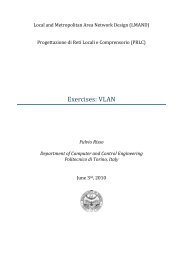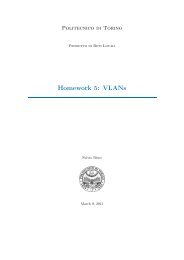High-Speed Policy-based Packet Forwarding Using Efficient Multi ...
High-Speed Policy-based Packet Forwarding Using Efficient Multi ...
High-Speed Policy-based Packet Forwarding Using Efficient Multi ...
Create successful ePaper yourself
Turn your PDF publications into a flip-book with our unique Google optimized e-Paper software.
authenticate the access. Clearly, filtering mechanisms are<br />
very useful at the edge of an enterprise network. In an edge<br />
network node, the router might need to identify the traffic<br />
that is initiated from specific customers, and either police<br />
it or shape it to meet a predefined contract. Indeed, these<br />
are the actions that are required by some of the differentiated<br />
services model proposals that are being considered for<br />
standardization by the IETF [lo].<br />
It is evident that most filter rules naturally apply to a<br />
whole range of addresses, port numbers, or protocols, and<br />
not just to single predefined hosts or applications. Aggregation,<br />
for instance of addresses, is not only required because<br />
customers are usually allocated blocks of addresses,<br />
but also because it is necessary to keep the network manageable.<br />
Therefore, the specification of the packet classification<br />
policies must allow aggregations in their definitions. This<br />
means that packet classification algorithms must be be able<br />
to process rules that define combinations of ranges of values.<br />
If the algorithms can only handle exact values and do not<br />
support aggregation, preprocessing is required to translate<br />
the ranges to exact values. This is infeasible since ranges<br />
can grow exponentially with length of the packet field on<br />
which the ranges are defined.<br />
A trend worth noting is that even though packet filtering<br />
was thought of as a tool necessary only at the network access<br />
points and mainly for firewall or security applications,<br />
it is now becoming apparent that it is a valuable tool for<br />
performing traffic engineering and meeting the new service<br />
requirements of the commercial Internet. Filtering policies<br />
that use the full information of the packet header can be<br />
defined for distributing the available system or network resources.<br />
The main consequence of these new uses is that<br />
all packet classification actions must be performed at wirespeed,<br />
i.e., the forwarding engines must have enough processing<br />
power to be able to process every arriving packet<br />
without queueing since without header processing it is not<br />
possible to differentiate packets to provide differentiated services.<br />
The main contributions of this paper are algorithms that<br />
use multi-dimensional range matching that enable Gigabit<br />
routers to provide wire-speed packet filtering and classification<br />
in a traffic independent manner (i.e. we do not<br />
rely on traffic dependent caching or average case results to<br />
achieve fast execution times). To our knowledge, our proposed<br />
schemes are the first schemes that allow thousands of<br />
filter rules to be processed at speeds of millions of packets<br />
per second with range matches on 5 or more packet fields<br />
in a traffic independent manner. Specifically, we present<br />
three algorithms: The first algorithm takes advantage of<br />
bit-level parallelism which combined with very elementary<br />
bit-operations results in a scheme that supports a large number<br />
of filter rules. The second algorithm extends the performance<br />
of the first algorithm by making efficient use of memory.<br />
It provides a means for balancing the the time-space<br />
tradeoff in implementation, and allows optimization for a<br />
particular system taking into account the available time for<br />
packet processing, the available memory, and the number<br />
of filter rules to be processed. Furthermore, the algorithm<br />
allows on-chip memory to be used in an efficient and traffic<br />
independent manner for reducing worst-case execution time.<br />
This is unlike typical caching schemes which are heavily traffic<br />
dependent and only improve average case performance.<br />
The performance metric for all our schemes is worst-case<br />
execution time, simple operations to make it amenable to<br />
hardware implementation if necessary, and space requirements<br />
which are feasible with current memory technology<br />
and costs. The implementation simplicity, scalability and<br />
performance of our filtering have been demonstrated in a<br />
prototype router with interfaces operating at a million packets<br />
per second.<br />
Our third algorithm considers the special case of filter<br />
rules on two fields. This is motivated by important applications<br />
such look-ups for multicast traffic forwarding and<br />
policy-<strong>based</strong> routing. To elaborate on this example, when<br />
a forwarding engine supports a multicast protocol like PIM<br />
(sparse mode or dense mode) [13] or DVMRP [26], the forwarding<br />
decision has to be made on both the source address<br />
value and the multicast group value. Depending on the protocol,<br />
the forwarding engine may have a forwarding entry<br />
for a given group value irrespective of source addresses, and<br />
also have forwarding entries for a given group value and<br />
source subnet. Given the increasing importance of multicast<br />
forwarding in the Internet, it would be ideal if a simple<br />
algorithm could be used for making multicast forwarding<br />
decisions. Since the search for the source addresses may use<br />
the same forwarding information base as that used for unicast<br />
routing, the same type of CIDR (Classless Inter-Domain<br />
Routing) aggregations [15] are likely to be used. CIDR aggregations<br />
introduced the notion of prefix in the definition<br />
of routing entries. In other words an entry in the forwarding<br />
base is defined as a value and a mask. The mask defines the<br />
number of bits of the destination address of a packet that<br />
can be ignored when trying to match the destination ad-<br />
dress of the packet to the particular entry of the forwarding<br />
base. The bits that can be masked-out are always in the<br />
less significant portion of the address. Thus, the values in<br />
the forwarding engines can thought as prefixes. For the case<br />
of IPv4, prefixes can have a length between 1 and 32 bits.<br />
We present a linear space, O(prefix length) scheme which<br />
can be used to implement P-dimensional lookups at rates of<br />
millions of packets per second for more than 128K entries in<br />
the forwarding table. Considering that multicast forwarding<br />
tables in the core backbone might include several hundreds<br />
of thousands of entries, even a solution that uses O(n log n)<br />
space with a moderate constant or O(Zog2n) time may not<br />
be feasible when the number of entries n is that high.<br />
2 Design Goals<br />
We first try to identify the main requirements that a packet<br />
classification algorithm must satisfy in order to be useful in<br />
practice.<br />
2.1 The Requirement for Real-Time Operation<br />
Traditional router architectures are <strong>based</strong> on flow-cache architectures<br />
to classify packets. The basic idea is that packet<br />
arrivals define flows [9, 171, in the sense that if a packet belonging<br />
to a new flow arrives, then more packets belonging<br />
to that flow can be expected to arrive in the near future.<br />
With this expected behavior, the first packet of a flow is<br />
processed through a slow path that analyzes the complete<br />
header. The header of the packet is then inserted into a<br />
cache or hash table together with the action that must be<br />
applied to the first packet as well as to all other packets of<br />
the flow. When subsequent packets of that flow arrive the<br />
corresponding action can be determined from the cache or<br />
hash table.<br />
There are three main problems associated with this architecture<br />
or any similar cache-<strong>based</strong> architecture when applied<br />
to current Internet requirements:<br />
204



